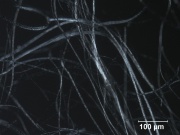Difference between revisions of "Alumina"
(username removed) |
(Undo revision 30459 by Contributions/ ([[User talk:|talk]])) |
||
| Line 1: | Line 1: | ||
| + | [[File:95_Alumina fiber_200X adj.jpg|thumb|Saffil, ICI Americas]] | ||
| + | == Description == | ||
| + | Common name for natural or synthetic [http://cameo.mfa.org/materials/fullrecord.asp?name=aluminum oxide aluminum oxide]. It is a white, hard, insoluble powder. Aluminum oxide naturally occurs in some feldspars, [http://cameo.mfa.org/materials/fullrecord.asp?name=alumina trihydrate alumina trihydrate], [http://cameo.mfa.org/materials/fullrecord.asp?name=corundum corundum], gibbsite, [http://cameo.mfa.org/materials/fullrecord.asp?name=bauxite bauxite], [http://cameo.mfa.org/materials/fullrecord.asp?name=ruby ruby], and [http://cameo.mfa.org/materials/fullrecord.asp?name=sapphire sapphire]. It was first extract commercially from bauxite in 1888 using the Bayer process. Aluminum oxide is extremely hard and is used as an abrasive both in its natural (corundum, [http://cameo.mfa.org/materials/fullrecord.asp?name=emery emery]) and synthetic (Alundum) forms. Synthetic alumina is prepared primarily in three forms: activated alumina, smelter-grade alumina, and calcined alumina. The porous, granular activated alumina aggressively absorbs liquid water and water vapor. The fine-grain calcined alumina is a dense impermeable ceramic material used for abrasives, refractories, electrical insulation, high temperature crucibles, and dental restoration. It is also used as a filler for paints, glass, and ceramics. When added to glaze mixtures, aluminum oxide increases viscosity during firing, prevents devitrification during cooling, and adds durability to the final surface. | ||
| + | |||
| + | See also [http://cameo.mfa.org/materials/fullrecord.asp?name=alpha alumina alpha alumina] and [http://cameo.mfa.org/materials/fullrecord.asp?name=gamma alumina gamma alumina]. | ||
| + | |||
| + | [[File:95_Alumina fiber_200X_pol adj.jpg|thumb|Saffil, ICI Americas]] | ||
| + | == Synonyms and Related Terms == | ||
| + | |||
| + | aluminum oxide; aluminium oxide; almina (Esp.); alumine (Fr.); alumina (Port.); xido de alumnio (Port.); activated alumina; Alundum; Aloxite; Bausilite; White Bauxilite; corundum | ||
| + | |||
| + | [[[SliderGallery rightalign|aaiAlumina.jpg~FTIR]]] | ||
| + | |||
| + | == Other Properties == | ||
| + | |||
| + | Soluble in mineral acids and strong alkali. Insoluble in water. | ||
| + | |||
| + | {| class="wikitable" | ||
| + | |- | ||
| + | ! scope="row"| Composition | ||
| + | | Al2O3 | ||
| + | |- | ||
| + | ! scope="row"| CAS | ||
| + | | 1344-28-1 | ||
| + | |- | ||
| + | ! scope="row"| Mohs Hardness | ||
| + | | 9.0 | ||
| + | |- | ||
| + | ! scope="row"| Melting Point | ||
| + | | 2040 | ||
| + | |- | ||
| + | ! scope="row"| Molecular Weight | ||
| + | | mol. wt. = 101.96 | ||
| + | |} | ||
| + | |||
| + | == Hazards and Safety == | ||
| + | |||
| + | Fire retardant. Dust may cause irritation with skin contact or inhalation. | ||
| + | |||
| + | Mallinckrodt Baker: [http://www.jtbaker.com/msds/englishhtml/a2844.htm MSDS] | ||
| + | |||
| + | == Comparisons == | ||
| + | |||
| + | [[media:download_file_167.pdf|Properties of Common Abrasives]] | ||
| + | |||
| + | |||
| + | |||
| + | == Additional Images == | ||
| + | |||
| + | <gallery> | ||
| + | File:95_Alumina fiber_500X_pol adj.jpg|Saffil, ICI Americas | ||
| + | </gallery> | ||
| + | |||
| + | |||
| + | == Authority == | ||
| + | |||
| + | * G.S.Brady, G.S.Brady, ''Materials Handbook'', McGraw-Hill Book Co., New York, 1971 Comment: p. 34 | ||
| + | |||
| + | * ''Encyclopedia Britannica'', http://www.britannica.com Comment: alumina" from Encyclopdia Britannica Premium Service. [Accessed May 8, 2003]. | ||
| + | |||
| + | * Michael McCann, Michael McCann, ''Artist Beware'', Watson-Guptill Publications, New York City, 1979 | ||
| + | |||
| + | * Robert Fournier, Robert Fournier, ''Illustrated Dictionary of Practical Pottery'', Chilton Book Company, Radnor, PA, 1992 | ||
| + | |||
| + | * R.M.Organ, R.M.Organ, ''Design for Scientific Conservation of Antiquities'', Smithsonian Institution, Washington DC, 1968 | ||
| + | |||
| + | |||
| + | |||
| + | [[Category:Materials database]] | ||
Revision as of 15:56, 30 September 2014
Description
Common name for natural or synthetic oxide aluminum oxide. It is a white, hard, insoluble powder. Aluminum oxide naturally occurs in some feldspars, trihydrate alumina trihydrate, corundum, gibbsite, bauxite, ruby, and sapphire. It was first extract commercially from bauxite in 1888 using the Bayer process. Aluminum oxide is extremely hard and is used as an abrasive both in its natural (corundum, emery) and synthetic (Alundum) forms. Synthetic alumina is prepared primarily in three forms: activated alumina, smelter-grade alumina, and calcined alumina. The porous, granular activated alumina aggressively absorbs liquid water and water vapor. The fine-grain calcined alumina is a dense impermeable ceramic material used for abrasives, refractories, electrical insulation, high temperature crucibles, and dental restoration. It is also used as a filler for paints, glass, and ceramics. When added to glaze mixtures, aluminum oxide increases viscosity during firing, prevents devitrification during cooling, and adds durability to the final surface.
See also alumina alpha alumina and alumina gamma alumina.
Synonyms and Related Terms
aluminum oxide; aluminium oxide; almina (Esp.); alumine (Fr.); alumina (Port.); xido de alumnio (Port.); activated alumina; Alundum; Aloxite; Bausilite; White Bauxilite; corundum
Other Properties
Soluble in mineral acids and strong alkali. Insoluble in water.
| Composition | Al2O3 |
|---|---|
| CAS | 1344-28-1 |
| Mohs Hardness | 9.0 |
| Melting Point | 2040 |
| Molecular Weight | mol. wt. = 101.96 |
Hazards and Safety
Fire retardant. Dust may cause irritation with skin contact or inhalation.
Mallinckrodt Baker: MSDS
Comparisons
Properties of Common Abrasives
Additional Images
Authority
- G.S.Brady, G.S.Brady, Materials Handbook, McGraw-Hill Book Co., New York, 1971 Comment: p. 34
- Encyclopedia Britannica, http://www.britannica.com Comment: alumina" from Encyclopdia Britannica Premium Service. [Accessed May 8, 2003].
- Michael McCann, Michael McCann, Artist Beware, Watson-Guptill Publications, New York City, 1979
- Robert Fournier, Robert Fournier, Illustrated Dictionary of Practical Pottery, Chilton Book Company, Radnor, PA, 1992
- R.M.Organ, R.M.Organ, Design for Scientific Conservation of Antiquities, Smithsonian Institution, Washington DC, 1968



